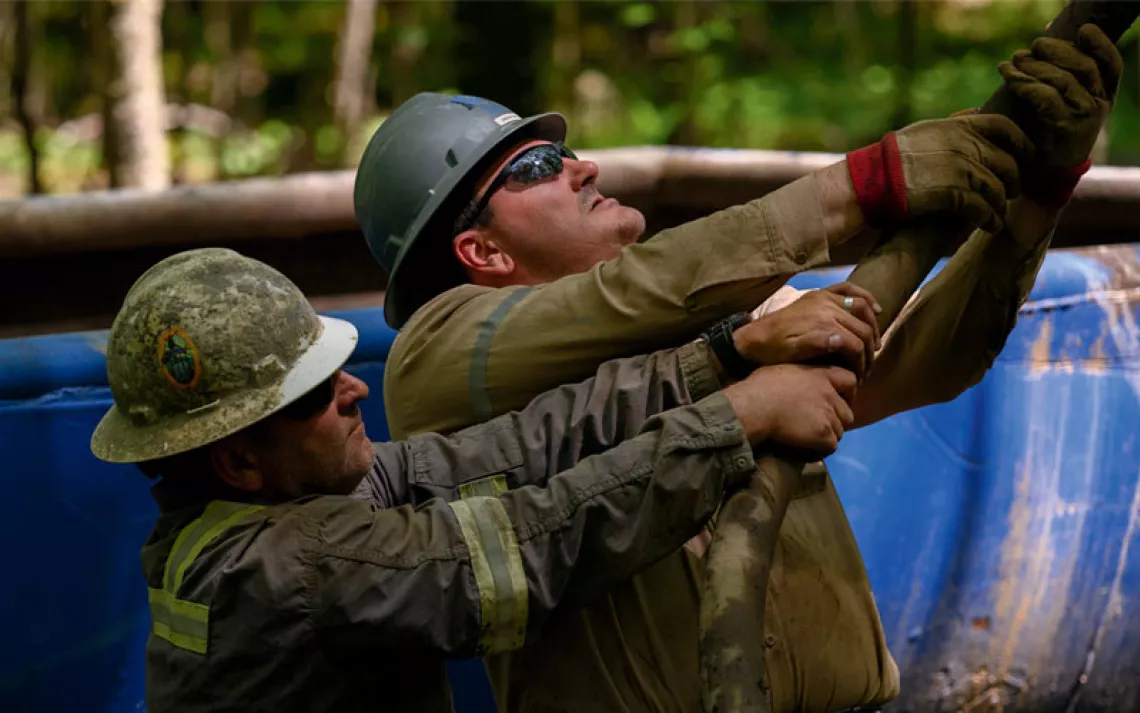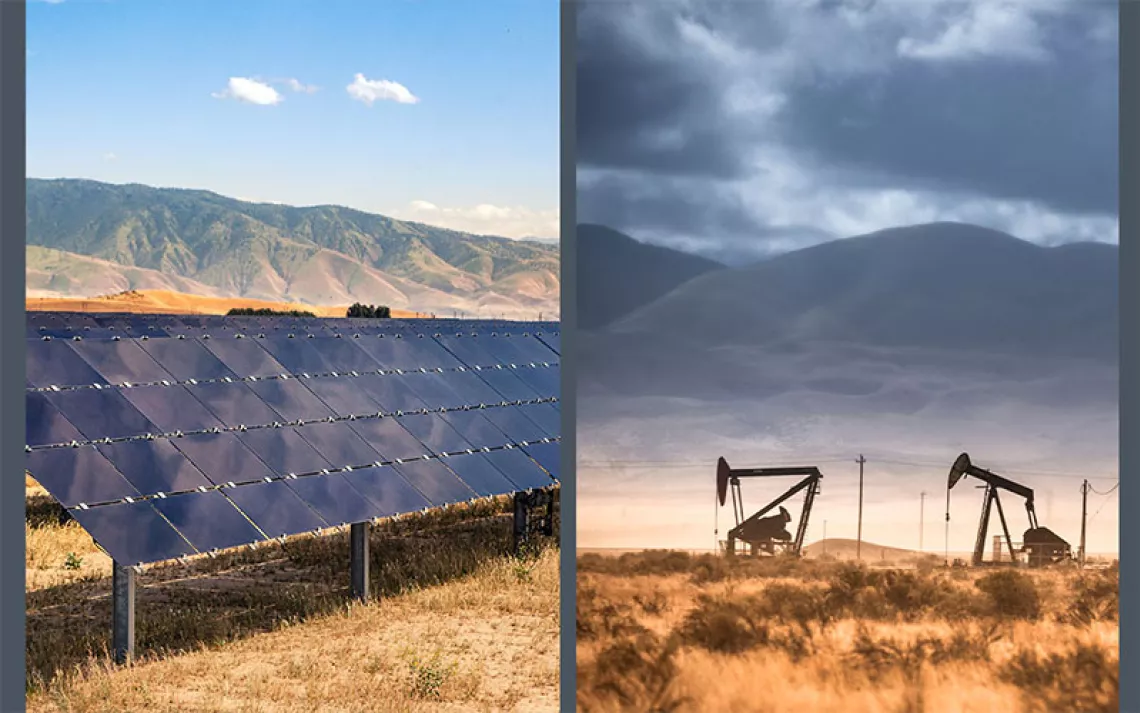The Trump Administration Wants to Drill in the Arctic. Do Oil Companies?
Economic headwinds, political uncertainty could hinder the fossil fuel industry's plans
In mid-August, the Trump administration finalized its plan to auction leases for oil and gas development in the Arctic National Wildlife Refuge, a remote tundra wilderness on Alaska’s North Slope. Secretary of the Interior David Bernhardt, a former oil and gas lobbyist, suggested that auctions could take place by the end of this year, praising the move as a boost for jobs and a step towards greater energy independence for the country.
But the administration’s announcement comes at a tumultuous time for the oil and gas industry. As such, it remains unclear whether oil companies will purchase the leases, let alone whether such a step would create jobs. Given the unfavorable economy, an upcoming election, and the inevitable lawsuits from Indigenous and environmental groups, the future of the Arctic Refuge is far from certain.
The 1.6-million-acre northern coastal plain of the refuge is thought to hold vast oil reserves, an assessment based on preliminary and minimal exploration in the mid-1980s. The US Energy Information Administration estimates the reserves to be around 10.4 billion barrels, though uncertainty remains as to the exact levels. What is known is that the coastal plain is an ecological hotspot for species like calving caribou, migratory birds, and hibernating polar bears. Moreover, it is central to the subsistence and culture of the Indigenous communities that live there.
Bernadette Demientieff, executive director of the Gwich’in Steering Committee, points out that the Gwich’in have lived in the area for more than 40,000 years, and that throughout history, the calving grounds in the coastal plain were considered too sacred even to enter. “Even during times of food shortage and starvation, our people never set foot in the calving grounds,” she says. “And right now they’re trying to turn it into an oilfield.”
“People think we’re environmentalists and activists, but we’re not—we’re mothers, fathers, grandmothers,” she says. “I have five grandchildren, and I’m worried about their future.” She says that politicians who are supposed to be representing the people are opting to support powerful development interests instead.
Whether or not to pursue oil and gas development in the Arctic has been a matter of contentious debate for the past five decades. The Senate almost opened the refuge to drilling in 2003, only to be stymied by a Democratic filibuster. In 2014, the Obama administration tried and failed to expand the refuge’s wilderness designation by an additional 5 million acres, a move that would have prohibited drilling, mining, roads, vehicles, and permanent buildings.
Then in 2017, congressional Republicans added a rider to the Tax Cuts and Jobs Act, an addition that Alaskan senator Lisa Murkowski made conditional on her support for the tax bill. Its passage opened the door for oil and gas development and required the first lease sale within the next four years.
Proponents of the measure made rosy predictions about job growth and high federal revenue. They claimed that $2.2 billion for the first lease sales—to be split between the federal government and the state of Alaska—would help offset the $1 trillion in tax cuts. By many indications, this figure appears to have been grossly overestimated. In May, Taxpayers for Common Sense, a nonpartisan watchdog, estimated that the government would reap only $9 to $14 million in revenues from the leasing, or less than 2 percent of the initial projection. (A 2018 Congressional Research Service report called revenues difficult to estimate, acknowledging that it would greatly depend on oil prices.)
Had the leasing decision come years earlier, oil and gas development would have been likely to follow. But the past decade has been one of steady decline for the fossil fuel industry. Last year, BP’s profits fell by 40 percent, and ExxonMobil’s profits fell by 49 percent. From 2014 to 2019, 240 oil and gas producers in North America filed for bankruptcy involving more than $171 billion in aggregate debt. An oil price war between Russia and Saudi Arabia this spring, coupled with the economic downturn from the pandemic, has only accelerated that trend.
How oil and gas companies are responding to this new reality varies greatly. According to Kathy Hipple, a financial analyst at the Institute for Energy Economics and Financial Analysis and a professor at Bard College, oil executives at major companies make decisions about exploration and development based on long-term forecasts—sometimes decades out. “We see that the oil companies are starting to diverge on where they view peak oil demand,” says Hipple. “Some of the companies such as Exxon are saying, as recently as its second-quarter earnings call, nothing has fundamentally changed. Whereas BP has said, ‘Things have fundamentally changed; we are radically rethinking our business.’”
Last August, the British-based corporation sold its entire business in Alaska to Hilcorp, a Texas-based oil company, as part of its plan to divest substantial assets between 2019 and 2020. This June, BP sold its international petrochemicals unit, comprising some 14 manufacturing sites across Asia, Europe, and the United States, bringing its divestment to date to $15 billion.
Even in normal circumstances, the decision of whether or not to explore and develop remote oilfields is lengthy and complex. “Any project of this scope, once initiated, is expected to last a substantial number of years, so oil and gas exploration costs need to consider long-dated futures prices,” says Ehud Ronn, a professor of finance and co-director of the Energy Management and Innovation Center at the University of Texas. He says that in general, volatility in the market tends to delay investment, including in new drilling operations.
“When Shell failed to find profitable oil in the Chukchi Sea and then as the shale gas boom turned to a shale oil boom, a lot of companies just lost interest in Alaska, because there was way more oil to be produced in North Dakota and rural Texas and New Mexico,” says Lorne Stockman, a senior research analyst at Oil Change International. “The shale boom crashed the price of oil, essentially, by producing too much too quickly and oversupplying the oil market. And that has really curtailed prospects for Alaska.”
Nevertheless, Stockman does not rule out the possibility that some companies will be drawn to the refuge. “There may be some players that, for the sake of a few tens of million dollars—pocket change in the industry—might want to sign up for a couple leases and go out there and have a look. That’s a feature of the industry that takes those kinds of risks, on the prospect that something might happen down the line,” he said, adding that companies want to be in on the ground floor.
“Companies have been pretty tight-lipped about any plans,” says Ben Cushing, a senior campaign representative leading the Sierra Club Financial Advocacy campaign. “The major oil and gas companies like Chevron and Exxon and ConocoPhillips have deflected questions about this for years now and keep their cards close to their chest.”
But the economics are clear. Based on analyses she has read, Hipple believes that production costs in the refuge make the endeavor prohibitively expensive—the break-even costs in the Arctic could be more than twice the break-even costs in, for example, the Permian Basin.
The political calculus is decidedly more complicated. With any presidential election comes a future of regulatory and legal uncertainty, though if Trump loses in November, oil companies have a clear indication of what to expect from the new administration. Presidential candidate Joe Biden has stated unequivocally that his administration would roll back fossil fuel development, ending subsidies for the industry in favor of clean energy. During a February town hall in New Hampshire, Biden was asked about drilling in the Arctic Refuge, to which he responded: “Completely, totally opposed to it. . . . No more drilling on federal lands, period.”
Meanwhile in Alaska, politicians have steadily been pushing for more drilling. With the maturation of its oilfields, the state’s annual oil production has been declining since 2003, so this is hardly surprising. For pipelines to remain economically viable, says Stockman, they need to continue to develop new resources and keep oil flowing at high rates. (Alaska’s economy is deeply reliant on oil and gas. It’s the only state in the country that has no personal income tax or state sales tax, and residents have, since 1982, been given annual dividends calculated on the oil royalty revenue.)
Also quick to praise the announcement to auction leases was the American Petroleum Institute, the largest industry trade group in the United States. Frank Macchiarola, API’s senior vice president of policy, economics, and regulatory affairs, responded in a statement: “Today’s announcement brings us one step closer to unlocking Alaska’s energy potential, which will create good-paying jobs and provide a new revenue stream for the state.”
Proponents of leasing have been conspicuously silent about the reality of climate change and the fact that more drilling will only hasten its worst impacts in the Arctic and globally. Stockman says that, compared with their European counterparts, the United States–based oil companies are particularly tone deaf when it comes to action on climate change. “They have an ideological position that is basically that nothing should be off limits,” he says. “So whether it’s viewed as economically viable and realistic from where we stand today and today’s markets, they have been pushing to open up everything. . . . And the Trump administration has been completely compliant.”
But there are signs of shifting headwinds in the finance sector. According to The Guardian, a group of investors managing more than $2.5 trillion asked banks and oil companies not to back efforts to open the Arctic Refuge to oil and gas development, calling it an “irresponsible business decision.” This week, a Norwegian pension fund worth $91 billion announced that it would divest from Chevron and Exxon over climate lobbying activities, and last year, Goldman Sachs became the first of five large US banks to announce that it would restrict its funding for the oil and gas sector and coal projects while explicitly condemning developments in the Arctic Refuge. The CEO of BlackRock, the world’s largest investment firm, signaled similar seismic changes when he asked investors in an open letter to weigh the risks of climate change.
“Many financial institutions have gotten investor pressure and investor scrutiny about their behavior and lending practices and insurance practices,” says Hipple. “It’s not only a question of whether the banks will fund this, but if the insurance companies insure this.” She notes that such investments are very high profile and high risk. “They can say [they’re] doing something to protect the climate, but at the end of the day, many of these financial institutions may back away because of the financial risk involved.”
“Major banks continue to pour a lot of money into fossil fuels,” says Cushing. “But we have seen some of the biggest banks in the world and in the United States begin to change their policies around fossil fuel financing.” While the trend certainly isn’t happening fast enough, he adds, it is underway.
Political and economic volatility aren’t the only factors that the fossil fuel industry, and the institutions that fund it, must confront. At the end of the day, oil companies are far from immune to public opinion. For instance, in 2015, Shell was forced to abandon an offshore drilling operation in the Arctic, due primarily to economics but in part because of public pressure. Memories of the Exxon Valdez spill in Alaska and the Deepwater Horizon oil spill in the Gulf of Mexico persist in the collective consciousness. According to a recent George Mason and Yale University poll, 67 percent of voters oppose oil drilling in the refuge, with voters who strongly oppose it outnumbering supporters by almost four to one. With enough pressure from activists and others, destroying public lands in exchange for minimal profits could ultimately prove to be too much of an uphill battle.
 The Magazine of The Sierra Club
The Magazine of The Sierra Club



